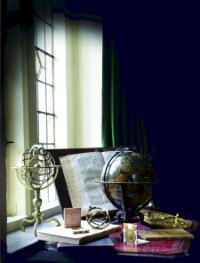The mathematician, cosmographer, and globe- and instrument-maker Gemma Frisius, of the medical faculty of the University of Louvain, read of Copernicus’s theory in the Narratio prima of Rheticus. Like Reinhold, he saw the potential for a more exact mathematical astronomy, whether or not the central hypothesis was taken to be true.
A well-known engraved portrait of Gemma shows him seated at a table strewn with drawing instruments and tools. Behind him are shelves filled with books, as well as an armillary sphere, a quadrant and an astrolabe. Both his hands are on a celestial globe of his own making. Astronomy is practiced through craft as well as calculation.
Gemma’s popular editions of the book Cosmographia of Peter Apian contained several paper instruments with moving parts. His Antwerp publisher, Roeland Bollaert, had a good trade in selling globes by Schöner, but demand outstripped supply and he persuaded Gemma to move into globe production. Gemma acknowledged his debt to Schöner for many of the features he adopted – not least the cosmographical device of pairing a celestial globe with a terrestrial of the same size.
Gemma’s workshop in Louvain also produced brass astronomical instruments and two are included in the exhibition
Featured Objects
19. Peter Apian and Gemma Frisius, Cosmographia (Antwerp, 1584)
20. Astrolabe (cosmographical mirror) and universal altitude sundial by Gillis Coignet, Antwerp, 1560
22. Astronomer’s rings by Gualterus Arsenius, Louvain, 1567
23. Astrolabe by Regnerus Arsenius, Louvain, 1565
Previous Panel: Rheticus, Copernicus and Reinhold
Next Panel: Gerard Mercator

